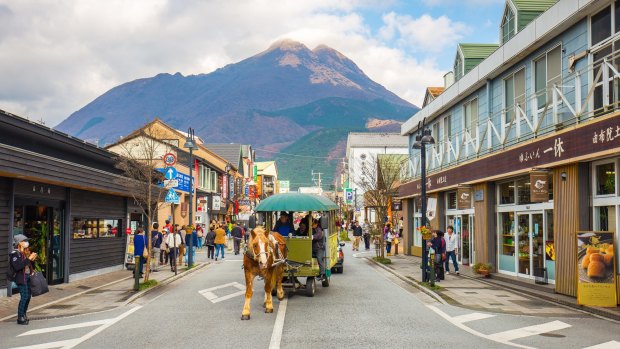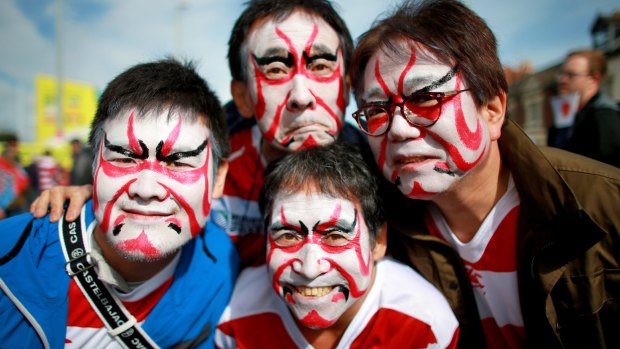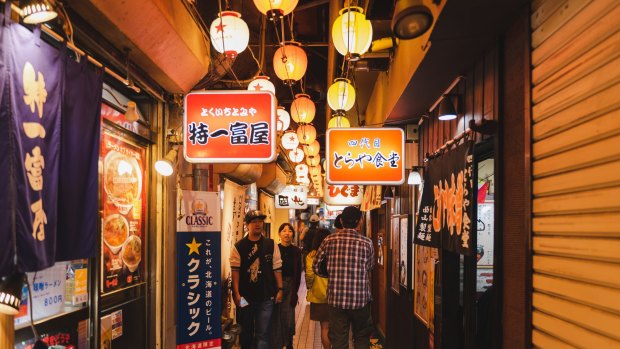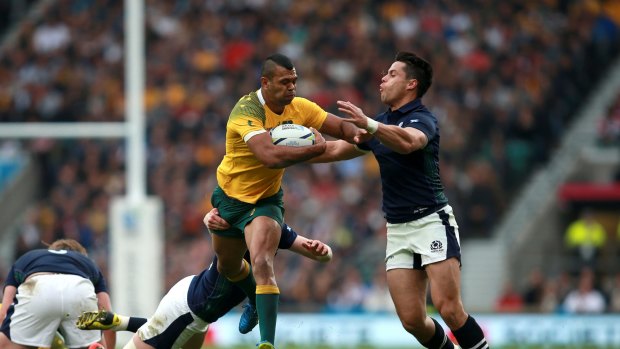This was published 5 years ago
Rugby World Cup 2019, Japan: Five places to visit beyond Tokyo
By Georgina Robinson

Mount Yufu n in Oita, Japan.Credit: Alamy
Oita, a little-known coastal province in the north-eastern corner of Japan's southern island, Kyushu, is a lush, mountainous gem, home to hot-springs towns, dense jungle filled with iridescent flowers and candy-striped insects, ancient Buddhist sculptures and quaint villages, perfect for exploring on foot.
It offers a sense of a more rural and wild Japan than the traditional Australian favourites like Tokyo, Kyoto and Osaka. Oita is also the unlikely setting for one of this year's biggest sporting festivals: one of the pool games for the Australian Wallabies' 2019 Rugby World Cup campaign, hosted by Japan, will be played here.
The Rugby World Cup has a proud history of showcasing its host nations like few other global sporting events are able to. Unlike its more intensely scheduled and single-city contained cousin, the Olympics, which will be hosted by Tokyo in 2020, the Rugby World Cup's eight-week schedule will allow Japan to present visitors with a full range of attractions beyond the rugby itself.

Japan fans before the Rugby World Cup match at the Kingsholm Stadium, Gloucester, in 2015.
Take my own experience. At least four times in the space of a week last year, in a pre-Rugby World Cup visit, I felt I experienced the real Japan. I found myself alone in a lotus field in the country's tropical south; perched on a stool on the edge of a bustling Tokyo izakaya, or pub; sprinting through driving rain in Moerenuma Park, Sapporo's dramatic yet whimsical ode to green space and architecture, and padding through Asakusa, the capital's old town, bound and wrapped in a traditional yukata, or cotton bathrobe, and feeling for the first time that I fit in, even as I also, plainly, stood out.
With fewer than 200 days, or six months more or less, to go before kick-off, this is the first time in its 32-year history that the tournament will be staged in Asia and in a non-traditional rugby nation. Held across 12 cities on three of the country's four main islands, it is expected to draw up to 400,000 foreign visitors. Demand has been huge; more than 5 million applications for 1.8 million available tickets.
Just as New Zealand unfurled like a glittering silver frond during its 2011 Rugby World Cup hosting, Japan will be changed by its dance with this international sporting showpiece followed by an Olympic Games. Rugby crowds are loud, they're big drinkers, but they're also – broadly – enthusiastic and respectful travellers.

Looking for a ramen restaurant in Ganso Sapporo Ramen Yokoch.Credit: Shutterstock
In Japan, rugby runs a distant third to football and baseball in the popularity stakes, but Japanese hospitality, perfectionism and sense of collective purpose should make this World Cup one like no other.
The only rule for those on the Wallabies trail this year is to not be confined by Tokyo as there's a whole country to discover. Here are five good places to start if you're following the Wallabies this year (and even if you're not).
SMALL CITY, BIG HEART

Australia's Kurtley Beale (centre) evades the challenges of Scotland's Finn Russell (left) and Sean Maitland during the 2015 Rugby World Cup in England.
Australians will be familiar with Sapporo as a winter playground, their base for ski and snow adventures on Japan's northern island of Hokkaido. But, come the Rugby World Cup in September, the city will show a different face, as a vibrant, open and accessible city, with Australia's first pool match, against Fiji, on the afternoon of September 21.
A trip up the Sapporo TV Tower is a good way to orient yourself, with much of the city of 1.9 million observable from its viewing deck 90 metres above ground. In clear conditions you will be able to see Sapporo Dome, the baseball stadium that has been modified to host World Cup matches.
If you've arrived with time to spare, the famous Sapporo Beer Museum will do a roaring trade throughout the tournament, but just next door a creative arts precinct offers the chance to see the work of the region's craftspeople and artists up close.
A traditional fishing and port city, Sapporo is famous for its glass-blowing. The Otaru Taishou Glass Palace, housed in the brick warehouse precinct, showcases this centuries-old craft, with glass-blowing classes available and a gift shop showcasing a charming fusion of Japanese kitsch and miniatures with the stunning possibilities of glass.
Lunch or dinner should be taken in one of the many fine seafood restaurants in town, and this is the city of seafood pubs such as the popular Hachikyo, remembering that Hokkaido is the only place in the world where you can buy Sapporo "Classic", the lager version of the ubiquitous Japanese beer.
Sapporo is the place to take in some adventure between matches, too, with horseriding and wild-plant foraging among the options on offer at that time of year.
A must-see attraction is Moerenuma Park, a vast public space of rolling hills, sculpture, fountains and a gallery enclosed in a sparkling glass pyramid. In winter it's home to sledding and cross-country skiing, but in September it will offer the burnished reds and oranges of early autumn foliage, and an opportunity to explore its green expanse.
See en.visit-hokkaido.jp; sapporobeer.jp; moerenumapark.jp/english
THE DEEP GREEN SOUTH
A year-and-a-half out from the tournament, the municipal government in Oita, where the Wallabies will meet Uruguay on October 5, already had its "Oita welcomes Rugby World Cup 2019" signs posted proudly at the airport, welcoming visitors who had taken the 90-minute flight from Tokyo.
The coastal prefecture is one of those smaller regions beyond the major cities that the Rugby World Cups seem made for, in a similar fashion to Bath, England, in 2015, or Nelson, New Zealand, in 2011. These are communities that recognise the economic and cultural opportunities presented by an influx of tourists and gladly roll out the welcome mat.
Hiring a car is the best way to unlock the area, which is dominated by Mount Yufu, an active volcano. Drive north to Beppu, a city by the sea with palm trees along the front and the smell of sulphur in the air, courtesy of the many natural vents that send whispers of steam up between houses and on roadsides.
Here, most ryokans (guest houses) proudly boast their own, natural onsen, which offer night-time star gazing while your troubles melt away in crystal-clear, 40-degree water. Ryokan Kiraku offers a traditional, rustic experience, including hot sand baths (sunaburo), elegant tatami mat and fusuma paper-screen rooms, futon bedding and a multi-course dinner (kaiseki) filled with local seafood.
The area is famous for its "Hells of Beppu", a mind-blowing string of naturally-occurring volcanic pools in the city's hilly north. Azure, blood-red, mud, or filled with (imported) crocodiles, each has a different colour and temperature determined by its geological composition. They have an amusement-park feel to them, but are worth the time to marvel at their impossibility.
WHERE HI-TECH MEETS THE SACRED
Much of Japan's charm lies in its ability to present its ultra-modern and traditional faces in any given moment. The integration of old and new is seamless at times, and jarring at others, but always stimulating and thought-provoking.
In Yufu, a charming artists' town about 10 kilometres inland from Beppu, you can marvel at the new glass-and-timber pavilion-style library and tourist centre, place your ramen order electronically at a restaurant for lunch, then spend the afternoon in hushed, reverent silence, whittling pieces of cherry wood into chopsticks (hashi) at workshop Hashi-ya Ichizen.
In Tokyo, you can seek out the head-spinning neighbourhoods of Shibuya or Harajuku after spending a morning re-balancing yourself in the tranquil Hama Rikyu gardens overlooking Tokyo Bay.
Or surrender your body to the dressers at Asakusa Kimono Rental, where you will be wrapped and padded and wrapped again in towelling and muslin pieces until you resemble the box-like shape favoured for kimono or yukata.
This exquisite experience is the kind of off-beat activity Japan does so well. Choose your own kimono, watch an elegant woman pull and scrape your hair into submission, slide into geta – those charming, wooden platform shoes – then shuffle around one of the oldest districts in Tokyo, taking in the sights of a 7th-century Buddhist temple or observing the charming daily rituals of the many young families who call the neighbourhood home.
MORE THAN SASHIMI AND RAMEN
Easily some of the best and best-value food in Japan is found outside the big smoke. Those on the Wallabies' trail can look forward to some mouthwatering new experiences.
In Sapporo, try Hachikyo, where costumed servers chant "oisah!" triumphantly as they serve you heaped bowls of glistening salmon roe over rice. Here is the place to sit back and toast with your Sapporo Classic as platter after platter of sashimi arrive at your table.
At Beppu's Amami Tea House, tuck into toriten, tempura chicken pieces served with fresh lemon and yuzu chilli paste. (Think a lighter, crunchier, tangier and completely moreish take on fried chicken.)
Make it one dish in a lunch set that features the region's abundant vegetable crops in a delicious dango flat noodle soup and finishes with yaseuma, a thick, soft noodle dusted with kinako, a sweet, roasted soy flour.
In Yufu town, climb the narrow stairs to Mabushi Shin restaurant and sit down to a clay pot of rice and layered, thinly-sliced pieces of wagyu beef, chicken or eel.
Here the staff will guide you through eating the rice in stages. First with pickles, condiments and an array of locally grown vegetables, next with soup poured over it, and finally with the regionally-produced, melting meat. Washed down with beer, this is rugby-watching fuel at its very best.
RETURN TO TOKYO
None of this is to underplay the magnificence of Japan's sprawling capital, which will host pool matches, including the tournament-opening game between Japan and Russia on September 20, two quarter-finals and the bronze final on November 1. It will be a good base for travellers pitching up for the knockout rounds, being just a half hour's train ride from Yokohama.
And once you've spent time off the beaten track, it's fun to hop back on again and follow it all the way back to the neon crazy of Tokyo. Try Ginza Six for your shopping fix or spend a quiet morning browsing the book store and (flash) Starbucks on its top level. Head to a batting cage in Asakusa to perfect your swing on the mechanical pitch – it's open until 1am and easy to find with a giant glove above its entrance.
Channel your inner "salaryman'" and head to Rashomon izakaya, a heaving bar built into the foundations of the railway tracks at Yurakucho. With tables and crates on the sidewalk and the trains rattling above your head, you'll need to be assertive and adventurous to nab a spot and figure out what you're ordering. No matter, its charm is in its makeshift, stand-like feel, even after almost 70 years in operation.
Can't snaffle a spot? The stretch between Yurakucho and Shinbashi station is famous for its endless strips of casual, often stand-up eateries, bars, Chinese restaurants and Korean barbecue houses. You won't find many non-smoking havens but you will find the heart of Tokyo's noisy, drunken, after-work vibe. It's lots of fun.
Georgina Robinson, chief rugby reporter for The Sydney Morning Herald, is covering this year's Rugby World Cup. She visited Japan as a guest of the Tokyo Convention and Visitors Bureau. Rugby World Cup 2019 tickets are on sale until April 1. See sportsjourney.jp; rugbyworldcup.com
RUGBY WORLD CUP 2019 IN NUMBERS
20 Total number of teams
48 Total number of matches in 12 cities across three islands
4 Total number of weeks for pool matches, three rounds of knockouts (quarter-, semi- and final) and a bronze medal match
12 Total number of match venues
8 Number of Rugby World Cups held since the first in 1987
72,327 Seating capacity of Yokohama stadium, venue of final
WHERE THE WALLABIES WILL BE
SEPTEMBER 21
Australia versus Fiji, Sapporo
SEPTEMBER 29
Australia versus Wales, Tokyo
OCTOBER 5
Australia versus Uruguay, Oita
OCTOBER 11
Australia versus Georgia, Shizuoka
Sign up for the Traveller Deals newsletter
Get exclusive travel deals delivered straight to your inbox. Sign up now.